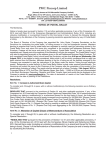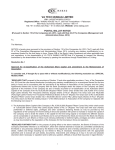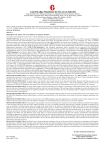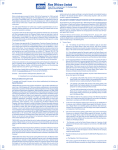Download LISTING RULE 7.1A– User Guide 1. Introduction This user's guide
Transcript
LISTING RULE 7.1A– User Guide 1. Introduction This user’s guide has been released to assist small and mid cap listed entities to understand and comply with the requirements of listing rule 7.1A. • Listing rule 7.1A permits listed entities that: meet the threshold eligibility criteria, and have obtained the approval of their ordinary security holders by special resolution at the annual general meeting (AGM), to issue an additional 10% of issued capital by way of placements over a 12 month period. • The exact calculation of the number of additional equity securities that an entity that may issue under listing rule 7.1A is governed by the formula in listing rule 7.1A.2. • The notice of AGM must contain the information required by listing rule 7.3A. • There are a number of other conditions applicable to the issue of equity securities under listing rule 7.1A, including a limitation on the discount to prevailing market price at which they may be issued, and additional disclosure requirements. • The approval under listing rule 7.1A ceases to be valid after 12 months, or if the listed entity approves a change of activities under listing rule 11.1.2 or the disposal of its main undertaking under listing rule 11.2. These matters are explained in more detail below. 2. Eligibility 2.1 2 eligibility criteria – market capitalisation level and non-inclusion in S&P/ASX 300 Index A listed entity must fit both of the following criteria at the time of its AGM in order to be eligible to seek ordinary security approval under listing rule 7.1A. (a) It must have a market capitalisation of $300 million or less. (b) It must not be included in the S&P/ASX 300 Index. An entity which does not comply with either or both of these criteria is ineligible to make use of listing rule 7.1A. 2.2 How to determine if a listed entity will be eligible The S&P/ASX 300 Index is rebalanced twice a year in March and September. S&P Dow Jones Indices publishes the names of the listed entities that are to be included in or removed from the S&P/ASX 300 Index on the first Friday of March and September, with the changes coming into effect on the third Friday of March and September. ASX will make available a list of the listed entities constituting the S&P/ASX 300 Index each time that the index is rebalanced. A listed entity which intends to seek security holder approval under listing rule 7.1A at its AGM will also need to ensure that it has a market capitalisation of $300 million or less at the time that the AGM is held. The basis on which a listed entity’s market capitalisation is calculated for this purpose is described in the definitions of ‘eligible entity’ and ‘market capitalisation’ in listing rule 19.12. For the purpose of the market capitalisation calculation, the price of the securities in the main class will be taken to be the closing price on ASX of those securities on the last trading day on which trades in the securities were recorded before the date of the AGM. ASX recommends that any entity that proposes to seek security holder approval under listing rule 7.1A at its AGM should provide a draft calculation of its market capitalisation to ASX at the time it lodges its draft notice of AGM for review. If a listed entity is considering seeking security holder approval under listing rule 7.1A, and it anticipates that by the time of the AGM it may be included in the S&P/ASX 300 Index, and/or that it may have a market capitalisation of greater than $300 million, it would be prudent for the notice of AGM to state that if the entity is in the S&P/ASX 300 Index or has a market capitalisation of greater than $300 million on the date of the AGM, then the resolution will be withdrawn. 2.3 What happens if a listed entity ceases to meet one of the eligibility criteria after it has obtained ordinary security holders’ approval? An approval under listing rule 7.1A lasts for 12 months from the date of the AGM, and does not lapse if the listed entity’s market capitalisation exceeds $300 million, or if it is included in the S&P/ASX 300 Index, at some time during that period. To seek another approval under listing rule 7.1A, the entity will need to meet both eligibility criteria at the date of its next AGM. 3. Security holder approval by special resolution at an Annual General Meeting Only eligible entities that have obtained ordinary security holder approval by a special resolution at the annual general meeting of the entity may issue equity securities under listing rule 7.1A. 3.1 Special resolution A specific definition of “special resolution” has not been included in the Listing Rules, so under listing rule 19.3 the term has the meaning that it is given in the Corporations Act 2001. Under s.9 of the Corporations Act, special resolution is defined as follows. “special resolution" means: (a) in relation to a company, a resolution: (i) of which notice as set out in paragraph 249L(1)(c) has been given; and (ii) that has been passed by at least 75% of the votes cast by members entitled to vote on the resolution; (b) in relation to a registered scheme, a resolution: (i) (ii) 3.2 of which notice as set out in paragraph 252J(c) has been given; and that has been passed by at least 75% of the votes cast by members entitled to vote on the resolution Annual general meetings A resolution under listing rule 7.1A can only be put at the annual general meeting of the listed entity. It may not be put at any other security holders’ meeting. 3.3 Can any equity securities be issued under listing rule 7.1A before the special resolution has been passed? No. The resolution must be passed first. 4. What is the additional placement capacity under listing rule 7.1A? Listing rule 7.1A permits eligible entities which have obtained security holder approval by special resolution to issue an additional 10% of the entity's issued ordinary securities. The formula is set out in listing rule 7.1A.2. The ability to issue securities under listing rule 7.1A is in addition to each listed entity's ability to issue securities under listing rule 7.1. For those securities that are issued under listing rule 7.1A, a maximum discount and additional disclosure requirements apply. 5. Interaction between listing rules 7.1 and 7.1A Under listing rule 7.1, every listed entity has the ability to issue 15% of its issued capital without security holder approval in a 12 month period. Only eligible entities that have obtained security holder approval by special resolution at an AGM have the ability to issue an additional 10% of issued capital in a 12 month period under listing rule 7.1A. When an entity issues or agrees to securities under listing rule 7.1 without security holder approval, that issue or agreement to issue uses up part of the 15% available under that rule. The number of securities that the entity has issued or agreed to issue is subtracted from the remaining placement capacity under listing rule 7.1. An issue or agreement to issue under listing rule 7.1 does not detract from an eligible entity's capacity to issue securities under listing rule 7.1A. Similarly, an issue or agreement to issue equity securities under listing rule 7.1A uses up part of the 10% available under that rule. The number of securities that the eligible entity has issued or agreed to issue is subtracted from the remaining placement capacity under listing rule 7.1A. An issue or agreement to issue under listing rule 7.1A does not detract from the eligible entity's capacity to issue securities under listing rule 7.1. An eligible entity must be clear which rule it is proceeding under whenever it issues securities or agrees to issue securities. This is because the eligible entity must keep separate its capacities to issue securities under these rules, demonstrate that it has complied with the limitation on the maximum discount permitted under listing rule 7.1A.3 for the issue price of securities issued under listing rule 7.1A, and make additional disclosures in relation to such issues. EXAMPLES Example 1 An eligible entity has 200 million ordinary securities on issue at the time of its AGM. All of those securities have been on issue for at least 12 months. It has no other quoted securities on issue. At the AGM, a resolution under listing rule 7.1A is passed. No other resolution seeking approval for the issue of securities is voted on. Immediately after the AGM, the entity has the capacity to issue: 30 million equity securities under listing rule 7.1 20 million equity securities under listing rule 7.1A Six months after the AGM, the entity issues 10 million ordinary securities as a placement at 90% of the prevailing market price. This placement can come under listing rule 7.1A because it complies with the discount limitation in listing rule 7.1A.3, and the securities are in an already quoted class. Following this placement, the entity has the capacity to issue: 30 million equity securities under listing rule 7.1 10 million equity securities under listing rule 7.1A One month later, the entity wishes to issue by way of a placement 20 million ordinary securities at 80% of the prevailing market price, and 20 million free attaching options. It can do so, using both: its remaining capacity of 10 million under listing rule 7.1A for half of the ordinary securities (because the ordinary securities are in a quoted class, and their issue price complies with the discount limitation under listing rule 7.1A3), and its capacity of 30 million equity securities under listing rule 7.1 for the other 10 million ordinary securities and all 20 million options. Following this placement, the entity does not have any further ability to issue equity securities under a placement without prior security holder approval. Example 2 An eligible entity has 400 million ordinary securities on issue at the time of its AGM. It has no other quoted class of equity securities. All of the ordinary securities have been on issue for at least 12 months. At the AGM, a resolution under listing rule 7.1A is passed. No other resolution seeking approval for the issue of securities is voted on. Immediately following the AGM, the entity has the capacity to issue: 60 million equity securities under listing rule 7.1 40 million equity securities under listing rule 7.1A Three months after the AGM, the entity issues 55 million ordinary securities as a placement at 70% of the prevailing market price. This placement has to come under listing rule 7.1 because it does not comply with discount limitation in listing rule 7.1A.3. Following this placement, the entity has the capacity to issue: 5 million equity securities under listing rule 7.1 40 million equity securities under listing rule 7.1A. One month later, the entity wishes to issue 10 million options under a placement. It cannot do so without obtaining prior ordinary security holder approval under listing rule 7.1. This is because it does not have sufficient capacity left under listing rule 7.1 to issue 10 million equity securities (it only has 5 million left), and it cannot use its capacity under listing rule 7.1A to issue equity securities in a new class. The Appendix 3B to the Listing Rules New issue announcement, application for quotation of additional securities and agreement (Appendix 3B) has been amended to include spaces for entities to disclose whether securities are being issued without security holder approval under listing rule 7.1, under listing rule 7.1A, with specific security holder approval under listing rule 7.3 or another rule, or under an exception in rule 7.2. This will help entities keep track of their remaining available placement capacities under both listing rules 7.1 and 7.1A from time to time (see paragraphs 8.3 and 9, below). 6. Security holders’ approval: Notice of AGM requirements 6.1 Notice of AGM - Special resolution A resolution under listing rule 7.1A can only be put at an eligible entity's AGM, and can only be proposed as a special resolution. 6.2 Specific information requirements for special resolution under listing rule 7.3A Listing rule 7.3A prescribes the information that must be included in the notice of AGM in relation to a resolution under listing rule 7.1A. The requirements are somewhat similar to the notice requirements set out in listing rule 7.3 for an approval under listing rule 7.1, but there are a number of important differences. The notice requirements for approvals under these rules are different principally because the time for which an approval under listing rule 7.1 is valid is only 3 months, while an approval under listing rule 7.1A is valid for 12 months. The notice in relation to a resolution under listing rule 7.1A must include disclosure of the following specific information. • Listing rule 7.3A.1. A statement of the minimum price at which securities may be issued pursuant to the listing rule 7.1A approval. This price must be consistent with listing rule 7.1A.3. (See paragraph 7 below for an explanation of the determination of the minimum price under listing rule 7.1A.3.) • Listing rule 7.3A.2. A statement of the risk of economic and voting dilution to existing ordinary security holders. The notice must include examples of the potential dilution effect on various scenarios, which must include one where the number of ordinary securities on issue has doubled and where the market price of the securities has halved. Additional examples may be given. • Listing rule 7.3A3. The final date for issue of securities under listing rule 7.1.A. This date must be 12 months after the date of the AGM, unless the entity's security holders approve a transaction under listing rule 11.1.2 (a significant change to the nature or scale of activities) or listing rule 11.2 (disposal of the main undertaking) before the anniversary of the AGM. • Listing rule 7.3A.4. Disclosure of the purposes for which the funds raised by issues of securities under listing rule 7.1A will be used. The notice of AGM must make clear whether any of the securities may be issued for non-cash consideration (that is, in consideration for assets, or any other consideration other than cash). If the notice of AGM does not specify that the listed entity intends to have the ability to issue securities under listing rule 7.1A for non-cash consideration, it will not be able to do so consistently with the terms of the security holders’ approval. 6.3 Allocation policy: listing rule 7.3A.5 Under listing rule 7.3A.5, the notice must disclose the allocation policy for the issue of securities under listing rule 7.1A. This requirement differs from the corresponding disclosure under listing rule 7.3.4 for a placement approved under listing rule 7.3, where the requirement is that the allottees of the placement, or the basis on which the allottees will be determined, be disclosed. This difference recognises that an issue under an approval pursuant to listing rule 7.1A may take place up to 12 months after the date of the AGM, and there is likely to be a greater degree of uncertainty about whether an issue of securities will ultimately be made, and if so, to whom. The disclosure of the allocation policy should address the question of how the entity intends to decide who to offer securities to under a placement pursuant to listing rule 7.1A in as much detail as is reasonably practicable in the circumstances, taking into account the entity’s intentions for fund raising and any other purposes for which it envisages that it may issue securities, the time frame over which the entity expects to make placements under the approval, and whether the entity has any specific intentions in relation to parties that it may approach to participate in a placement of equity securities. The disclosure of the allocation policy should address whether the entity has formed an intention to offer any of the securities to existing security holders, or to any class or group of existing security holders, or whether, alternatively, it has formed an intention to offer the securities exclusively to new investors who have not previously been security holders of the entity. As the entity will be required when it announces any issue or agreement to issue equity securities under listing rule 7.1A to disclose under listing rule 3.10.5A(b) why it undertook that particular issue as a placement rather than as, or in addition to, an entitlements issue or other issue in which existing security holders could have participated, the entity may wish to set out as part of its allocation policy under listing rule 7.3A.5 whether or not it intends to give consideration before making any placement of securities under listing rule 7.1A to whether the raising of any funds under such placement could be carried out by means of an entitlements offer, or a placement and an entitlements offer. 6.4 Voting exclusion statement: listing rule 7.3A.7 Under listing rule 7.3A.7 there must be a voting exclusion statement. The security holders whose votes are to be excluded are determined on the same principle as is applicable to voting exclusion statements for resolutions under listing rule 7.3. Any security holder who may participate in the proposed issue, and any security holder who would gain an advantage (other than an advantage solely in the capacity of an ordinary security holder) from the passing of the resolution, is not to have its votes counted. The associates of any person excluded from voting are also not to have their votes counted. It is the responsibility of the listed entity to decide at the time of the AGM if a security holder is someone who may participate in the proposed issue, or who may gain an advantage from the passing of the resolution, for the purposes of the voting exclusion statement. Without limiting the words of the rule, or derogating from the responsibility of each listed entity to make the determination of whether particular security holders’ votes are to be excluded, the following are three examples of the application of the voting exclusion statement in different scenarios relating to the selection of allottees of securities under listing rule 7.1A. • If the entity intends to offer equity securities under listing rule 7.1A to some particular existing security holders, or to an identifiable class of existing security holders, then the votes of those security holders are to be excluded. • If there is an agreement or understanding between the listed entity and any existing security holders that those security holders will be approached to participate in an issue made under listing rule 7.1A, then, whether or not those security holders have formed an intention as to whether they would accept such an offer, the votes of those security holders are to be excluded. Those security holders would have an interest in the outcome of the vote on the resolution that is potentially different from the security holders who will not be invited to participate. • If the listed entity does not intend to approach particular existing security holders or an identifiable class of existing security holders to participate in an offer of securities made under listing rule 7.1A, or if the entity does not know, and has not formed an intention in relation to how it will decide, which parties it may approach to participate in any issue that may ultimately be made, then no security holders' votes should be excluded. No security holder would have an interest in the outcome of the resolution that is potentially different form that of any other security holder. 6.5 Security holder approval under listing rule 7.1A after the first time: listing rule 7.3A.6 If an entity has previously obtained ordinary security holder approval under listing rule 7.1A, and seeks another approval under that rule at a subsequent AGM, then it must disclose additional information about all issues of equity securities it made during the preceding year. (Listing rule 7.3A.6) 7. Listing rule 7.1A.3: discount limitation. 7.1 Securities issued under listing rule 7.1A can only be in an existing quoted class Under listing rule 7.1A.3, securities issued under listing rule 7.1A must belong to a class of equity securities already quoted. Listing rule 7.1A cannot be used for placements of securities in a class that has not yet been quoted. 7.2 25% limit on discount to volume weighted average price at time of issue The issue price of securities issued under listing rule 7.1A must be no lower than 75% of the volume weighted average price for securities in the relevant quoted class calculated over the 15 trading days on which trades in that class were conducted immediately before either: (a) the date on which the securities are issued; or (b) the date on which the price of the securities is agreed, provided that the issue is thereafter completed within 5 business days. Setting the maximum discount by reference to a VWAP figure calculated over a period of 15 trading days should limit the potential for securities to be issued under listing rule 7.1A at a discount to a short term low market price. In recognition of the market practice that a listed entity and potential allottees of securities will come to an agreement about the issue price of the securities a short time before the issue actually takes place, and that they must be able to tell whether the price that they have agreed complies with the listing rule, the maximum discount can be calculated by reference to the VWAP over the 15 trading days on which trades in the equity securities were recorded before the agreement is reached. In this case, the issue must be completed (that is, payment for the securities must be received, and the securities issued into the electronic holdings of the allottees) within 5 business days after the agreement of the issue price. Otherwise the calculation must be performed by reference to the 15 trading days on which trades were recorded before the issue date. 7.3 VWAP calculations. VWAP calculations can be provided by ASX Customer Service and other third party service providers. A listed entity may use any recognised information service provider as the source of its VWAP calculation. The VWAP calculation, and the source used, must be disclosed when an issue securities under listing rule 7.1A is announced. A new item 6g has been included in the Appendix 3B for disclosing this information. 7.4 Issue of securities under listing rule 7.1A for non-cash consideration: calculation of value of the non-cash consideration If a listed entity has disclosed in the notice of AGM under listing rule 7.3A.4 that it may issue some of the securities under listing rule 7.1A for non-cash consideration, then securities may be issued under that rule as scrip consideration for the acquisition of assets. The entity must still comply with the minimum issue price limitation under listing rule 7.1A.3 in relation to such issues. This means that the entity must determine the value of the asset being acquired by the issue of securities, and must demonstrate that the deemed issue price of any securities issued in consideration of that asset (the value of the non-cash consideration divided by the number of securities issued) is no lower than 75% of the VWAP calculated over the 15 trading days on which trades in the securities are recorded immediately before the securities are issued. The valuation may be provided by an independent expert, or by the directors of the listed entity if they have appropriate expertise to carry out the valuation of the asset, and their report contains a similar level of analysis to that which would be expected in an independent expert’s report. The listed entity must release to the market a valuation of the non-cash consideration. It must be released to the market before the issue of securities. ASX may ask the listed entity to submit its valuation of the asset to the scrutiny of another independent expert (see listing rule 18.7). On the amended Appendix 3B, new item 6h reminds the listed entity that it must have disclosed the valuation of the non-cash consideration. 8. Additional disclosure to the market at time of issue of securities under listing rule 7.1A 8.1 Listing rule 3.10.5A When an issue of securities is made under listing rule 7.1A, the entity must disclose the specific information required by listing rule 3.10.5A. This is in addition to any information about the issue required by listing rule 3.10, the Appendix 3B, and any other applicable rules. Listing rule 3.10.5A requires disclosure of the following. (a) Details of the dilution to the existing holders of ordinary securities caused by the issue. This disclosure would be expected to address the percentage of the issued capital of the entity represented by the securities issued under the placement, and the percentage of the postplacement issued capital held by the pre-placement security holders. If some existing security holders, or a class of existing security holders, participated in the placement, the disclosure should show separately the percentage of the post-placement capital held in aggregate by: • • • pre-placement security holders who did not participate in the placement; pre-placement security holders who did participate; and participants in the placement who were not previously security holders. (b) Where the equity securities are issued for cash consideration, a statement of the reasons why the eligible entity issued the equity securities as a placement under rule 7.1A and not as (or in addition to) a pro rata issue or other type of issue in which existing ordinary security holders would have been eligible to participate. (c) Details of any underwriting arrangements, including any fees payable to the underwriter. (d) Any other fees or costs incurred in connection with the issue. 8.2 Listing rule 7.1A.3: securities issued for non-cash consideration Where securities are issued under listing rule 7.1A for non-cash consideration, the valuation of the non-cash consideration must be released to the market (see paragraph 7.4 above). 8.3 Amendments to Appendix 3B Whenever a listed entity issues or agrees to issue equity securities, it must lodge an Appendix 3B. In order to ensure that an eligible entity that has issued securities under listing rule 7.1A can demonstrate that it has complied with the requirements of that rule in relation to the issue, additional boxes have been included in Appendix 3B, numbered as items 6a to 6i, where the relevant information can be given. 9. Annexure 1 to Appendix 3B: to be included with every Appendix 3B lodged by an eligible entity To assist eligible entities and the market keep track of the entities’ issues of securities under both listing rules 7.1 and 7.1A, and how many equity securities they may issue under each of those rules from time to time, Annexure 1 to Appendix 3B has been introduced. Annexure 1 sets out in detail the calculation of the number of equity securities that an entity may issue under listing rules 7.1 and 7.1A. Every eligible entity that has obtained security holder approval under listing rule 7.1A must complete and lodge with ASX Market Announcements an Annexure 1 accompanying every Appendix 3B that the entity lodges. This is required regardless of whether the particular issue is made under listing rule 7.1A. 10. Listing rule 7.1A.4: list of allottees, not for disclosure to the market When an issue of securities under listing rule 7.1A is made, the listed entity must provide a list of the persons to whom the securities were issued to ASX. This information is not for disclosure to the market, but will assist listed entities ensure they do not issue any securities under listing rule 7.1A to parties to whom such an issue would not be permitted - for example, issues to related parties of the listed entity (which would be contrary to listing rule 10.11), or to persons where the issue would cause a person to have voting power greater than 20% in the entity (contrary to s. 606 of the Corporations Act). While the list of allottees is not for release to the market under listing rule 7.1.4A, ASX has a power under listing rule 18.7 to require a listed entity to give ASX any information that ASX requires in order to be satisfied that the entity is compliance with the Listing Rules. If it appeared from the list that securities had been issued contrary to a listing rule, ASX could require a listed entity to make a disclosure to the market about one of more of the allottees of a placement under listing rule 7.1A. The requirement to provide a list of allottees does not apply in the case of issues made under listing rule 7.1, an issue that has been approved under listing rule 7.3, or an exception in listing rule 7.2. 11. Listing rule 7.4 and 7.5: ratification of issues made under listing rule 7.1A Issues of securities made relying on listing rule 7.1A can, after they have been made, be ratified under listing rule 7.4. This has the effect of refreshing the entity's placement capacity under listing rule 7.1 and 7.1A to the extent that the previous issues made are ratified. The notice of securityholders’ meeting must contain the information required under listing rule 7.5 Note that while an eligible entity must obtain ordinary security holders’ approval by a special resolution before it may make any issues of equity securities under listing rule 7.1A, such issues are not considered as having been made with security holders’ approval under listing rule 7.1 for the purposes of variable “A” in the formulae in listing rules 7.1 and 7.1A. If ordinary fully paid securities are issued under listing rule 7.1A, they do not get included in the base figure “A” from which the entity’s ongoing placement capacity is calculated (under both listing rules 7.1 and 7.1A), until either the relevant issue has been ratified pursuant to listing rule 7.4, or 12 months has passed since the issue of the ordinary securities. Listed entities should take this into account when deciding whether they will seek ordinary security holders’ ratification of issues made under listing rule 7.1A. 12. Listing rule 7.1A.1 (b): automatic expiry of approval under listing rule 7.1A if a transaction under listing rules 11.1.2 or 11.2 is approved An approval under listing rule 7.1A lasts for exactly 12 months after the date of the AGM, unless the eligible entity’s security holders subsequently approve a transaction under either listing rule 11.1.2 (a significant change to the nature or scale of activities) or listing rule 11.2 (the disposal of the main undertaking). If such a transaction is approved, the listing rule 7.1A approval expires from the date of that approval. For the avoidance of doubt, the approval under listing rule 7.1A is taken to expire from the beginning of the day on which a resolution under listing rule 11.1.2 or 11.2 is to be voted on. The reason for the early expiry of the listing rule 7.1A approval in these cases is that a transaction that requires approval under either of those rules would represent a fundamental change to the listed entity’s business. In those circumstances, the entity should not continue to have the ability to issue equity securities under listing rule 7.1A on the basis that was approved at the previous AGM, when the nature of the activities towards which the entity would be devoting any funds raised by such issues would necessarily be different from those that could reasonably have been in the contemplation of security holders at the time that the approval was given. Please refer to Guidance Note 12 for more detailed information on ASX policy in relation to Chapter 11 of the Listing Rules.
























